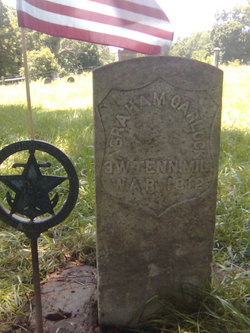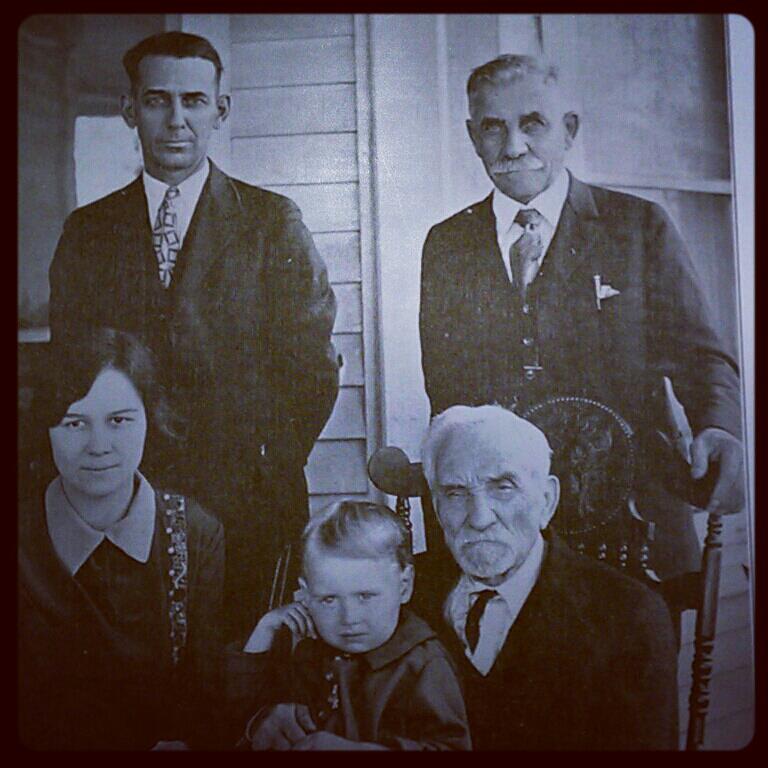----------------------
Abraham Carlock remains much beloved by his descendants.
Thanks to a book written in 1929 by his great grandson Marion P. Carlock, we have a wealth of biography on him.
Abraham was the oldest of 10 known children born to Hanchrist and Sarah Whitman Carlock. Family lore tells of Abraham making bullets for the soldiers of the Revolutionary War, one of them his father.
Abrahams youngest son, William Jackson Carlock, documented in a letter of how his father came to have only one hand.
When Abraham was a baby, he was sitting in a high chair next to a fireplace, and he fell from the chair with his hand falling into a skillet of hot grease. His fingers were burnt off up to the hand.
Despite this handicap, Abraham was well known for being proficient with his long barrel rifle. Here in Illinois, he was toted as being a keen marksman, and his ability to bring down a bear was highly respected.
After the death of his father, Abraham led a caravan from Virginia to Overton County Tennesee in 1803. Several of his brothers also settled in Tennessee at this time. Abraham brought along most of his eight children born to him and his first wife Abigail Osborn. Abigail is thought to have been killed by Indians in Virginia.
In Tennessee in 1803, Abraham would start a family with Mary Ann Lee, they had 9 children. Mary Ann would have raised the other children also, the oldest of her step children being 11 when they married.
While residing in Tennesee, Abraham and 2 of his sons, Reuben and Isaac, along with his brother Moses, fought in the War of 1812.
Abraham fought proudly with the 3rd West Tennesee Militia, which was present at the Battle of New Orleans. A descendant later told the story of how at first Abraham was rejected as a soldier because he had only one hand. At Abraham's insistence, he was able to prove to them he could load and fire his rifle with the best rifleman they could put up against him.
At the Battle of New Orleans, his grandson Winton Carlock related the story of how Abrahams first shot missed the British soldier he took aim at, but the remainder of his shots hit his targets. The Carlocks revered Andrew Jackson.
After the War of 1812, Abraham and Mary Ann with many of their children came to Illinois, first settling in Madison County.
Abraham would move several times before settling in Schyuler County, where he would make his final home. We can think it was only death that put an end to Abraham's pioneering spirit and his quest for new horiz0ns.
Abraham is an inspiration for his descendants. Besides overcoming physical impairment, he was highly thought of by the communities he formed and lived in. In 1825, he was selected to be a member of the first Grand Jury of the newly formed Schuyler County.
Abraham was laid to rest in Salisbury Cemetery. He was buried with no stone. In 1915, several of his great grandsons honored him by obtaining from the government a War of 1812 marker.
His Grandson Mark Mitchell Bassett, state senator and judge in Peoria County started the quest to obtain this stone.
Mark M. Bassett (1837-1910)
Unfortunately, Mark died before the stone was delivered. Present at a small ceremony October 6, 1915, were great grandsons George, Reuben, and W.L Carlock of Carlock Illinois. Also present was grandson W.B. Carlock of Mclean County Illinois.
Also present was grandson Wm Riley Weddle, son of Amos and Nancy Carlock Weddle. Wm Riley was the only person still alive that attended Abrahams original burial service. He was able to point out the unmarked grave of his grandfather Abraham.
No other Carlocks are buried in Salisbury Cemetery. The grave of Mary Ann is unknown to me at this time.
Abraham is buried near the place of his final homestead, with many of his neighbors. His stone was dark and tilted. Happily, only some water and elbow grease revealed a beautiful stone.
We are thankful for the life and legacy of Abraham Carlock.
Written by GGGG Grandaughter Debra
**********
Excerpted from The Combined History of Schuyler and Brown Counties, Illinois, 1882
Hickory Township
The first persons to settle in Hickory township were Jonathan Viles, Nicholson Viles, his uncle, William Stevenson, a son-in-law of Nicholson Viles, and Amos Richardson. In the spring of 1826 this party of pioneers crossed the Illinois river at Beard's ferry, and taking up an old Indian trail, followed it along the bluffs until reaching a point where Butlersville now stands, where they halted, and for a time camped together. They all settled along the bluffs and raised a few crops, and all but Amos Richardson, moved out of the township. He remained here, and about 1830 was shot and killed by Burrell Basset, who was then a resident or squatter. This affair is said to have occurred from trading wives. The next settler was Abraham Carlock, who arrived in 1827. He was a migratory individual, and moved about from place to place in the township for several years. It is related that he was a very old man when he came, and had a large family of grown children. He was minus his left hand, it having been burned off. He died here nearly forty years ago.
----------------------
Abraham Carlock remains much beloved by his descendants.
Thanks to a book written in 1929 by his great grandson Marion P. Carlock, we have a wealth of biography on him.
Abraham was the oldest of 10 known children born to Hanchrist and Sarah Whitman Carlock. Family lore tells of Abraham making bullets for the soldiers of the Revolutionary War, one of them his father.
Abrahams youngest son, William Jackson Carlock, documented in a letter of how his father came to have only one hand.
When Abraham was a baby, he was sitting in a high chair next to a fireplace, and he fell from the chair with his hand falling into a skillet of hot grease. His fingers were burnt off up to the hand.
Despite this handicap, Abraham was well known for being proficient with his long barrel rifle. Here in Illinois, he was toted as being a keen marksman, and his ability to bring down a bear was highly respected.
After the death of his father, Abraham led a caravan from Virginia to Overton County Tennesee in 1803. Several of his brothers also settled in Tennessee at this time. Abraham brought along most of his eight children born to him and his first wife Abigail Osborn. Abigail is thought to have been killed by Indians in Virginia.
In Tennessee in 1803, Abraham would start a family with Mary Ann Lee, they had 9 children. Mary Ann would have raised the other children also, the oldest of her step children being 11 when they married.
While residing in Tennesee, Abraham and 2 of his sons, Reuben and Isaac, along with his brother Moses, fought in the War of 1812.
Abraham fought proudly with the 3rd West Tennesee Militia, which was present at the Battle of New Orleans. A descendant later told the story of how at first Abraham was rejected as a soldier because he had only one hand. At Abraham's insistence, he was able to prove to them he could load and fire his rifle with the best rifleman they could put up against him.
At the Battle of New Orleans, his grandson Winton Carlock related the story of how Abrahams first shot missed the British soldier he took aim at, but the remainder of his shots hit his targets. The Carlocks revered Andrew Jackson.
After the War of 1812, Abraham and Mary Ann with many of their children came to Illinois, first settling in Madison County.
Abraham would move several times before settling in Schyuler County, where he would make his final home. We can think it was only death that put an end to Abraham's pioneering spirit and his quest for new horiz0ns.
Abraham is an inspiration for his descendants. Besides overcoming physical impairment, he was highly thought of by the communities he formed and lived in. In 1825, he was selected to be a member of the first Grand Jury of the newly formed Schuyler County.
Abraham was laid to rest in Salisbury Cemetery. He was buried with no stone. In 1915, several of his great grandsons honored him by obtaining from the government a War of 1812 marker.
His Grandson Mark Mitchell Bassett, state senator and judge in Peoria County started the quest to obtain this stone.
Mark M. Bassett (1837-1910)
Unfortunately, Mark died before the stone was delivered. Present at a small ceremony October 6, 1915, were great grandsons George, Reuben, and W.L Carlock of Carlock Illinois. Also present was grandson W.B. Carlock of Mclean County Illinois.
Also present was grandson Wm Riley Weddle, son of Amos and Nancy Carlock Weddle. Wm Riley was the only person still alive that attended Abrahams original burial service. He was able to point out the unmarked grave of his grandfather Abraham.
No other Carlocks are buried in Salisbury Cemetery. The grave of Mary Ann is unknown to me at this time.
Abraham is buried near the place of his final homestead, with many of his neighbors. His stone was dark and tilted. Happily, only some water and elbow grease revealed a beautiful stone.
We are thankful for the life and legacy of Abraham Carlock.
Written by GGGG Grandaughter Debra
**********
Excerpted from The Combined History of Schuyler and Brown Counties, Illinois, 1882
Hickory Township
The first persons to settle in Hickory township were Jonathan Viles, Nicholson Viles, his uncle, William Stevenson, a son-in-law of Nicholson Viles, and Amos Richardson. In the spring of 1826 this party of pioneers crossed the Illinois river at Beard's ferry, and taking up an old Indian trail, followed it along the bluffs until reaching a point where Butlersville now stands, where they halted, and for a time camped together. They all settled along the bluffs and raised a few crops, and all but Amos Richardson, moved out of the township. He remained here, and about 1830 was shot and killed by Burrell Basset, who was then a resident or squatter. This affair is said to have occurred from trading wives. The next settler was Abraham Carlock, who arrived in 1827. He was a migratory individual, and moved about from place to place in the township for several years. It is related that he was a very old man when he came, and had a large family of grown children. He was minus his left hand, it having been burned off. He died here nearly forty years ago.
Family Members
-
![]()
Isaac Carlock
1792–1843
-
![]()
Reuben Carlock
1795–1854
-
![]()
George Osborn Carlock
1800–1881
-
![]()
Abraham W. Carlock
1800–1884
-
![]()
Catharine Mary "Katy" Carlock Robbins
1801–1860
-
![]()
Nancy Carlock Mitchell
1804–1884
-
![]()
Anna Carlock Steel
1807–1881
-
Abigail Carlock Bassett
1809–1856
-
Jacob Madison Carlock
1811–1866
-
![]()
Miriam Carlock Haggerty
1813–1862
-
![]()
Ruth Carlock Settles
1817–1854
-
![]()
Penina Carlock Winebrenner
1819–1895
-
![]()
William Jackson Carlock
1823–1911























